Nuclear matter extrapolation
07/13/2009
Nuclear dependence of R: extrapolation to nuclear matter:
1) I used the two ε settings from E139 and our two highest Q2 settings.
2) For each ε I extrapolated to nuclear matter assuming different nuclear dependence: A-1/3, ρ, ρ*(A-1)/A, ...
3) I obtained the nuclear matter values for the four ε.
4) I extracted RNM-RD from these four ε'=ε/(1+ε*RD)
5) I still need to check the normailzation error propagation.
--> Each ε' point on Fig.1 was extracted from Figures 2-5 with A-1/3 dependence.
--> Extractions with other nuclear dependence are listed in Table 1 below.
Fig.1: RNM-RD extraction from nuclear dependence with A-1/3 nuclear dependence. LEFT PLOT= No coulomb correction, RIGHT PLOT= with coulomb correction
Table 1: results for RNM-RD from different nuclear matter extrapolations.
| Nuclear dependence |
RNM-RD no CC |
RNM-RD CC |
| A-1/3 |
-0.004 +/- 0.029 |
-0.091 +/- 0.029 |
| uniform sphere, ρ(A-1)/A |
-0.007 +/- 0.062 |
-0.083 +/- 0.063 |
| Wiringa-Pieper calcs, ρ(A-1)/A |
+0.013 +/- 0.072 |
-0.097 +/- 0.075 |
| uniform sphere, ρ |
-0.029 +/- 0.070 |
-0.086 +/- 0.070 |
| Wiringa-Pieper calcs, ρ |
-0.003 +/- 0.083 |
-0.096 +/- 0.083 |
Fig.2: from E139, ε'= 0.754 (ε= 0.828). LEFT PLOT= No coulomb correction, RIGHT PLOT= with coulomb correction
Fig.3: from E139, ε'= 0.656 (ε= 0.711). LEFT PLOT= No coulomb correction, RIGHT PLOT= with coulomb correction
Fig.4: from E03-103 (40deg), ε'= 0.382 (ε= 0.404). LEFT PLOT= No coulomb correction, RIGHT PLOT= with coulomb correction
Fig.5: from E03-103 (50deg), ε'= 0.267 (ε= 0.277). LEFT PLOT= No coulomb correction, RIGHT PLOT= with coulomb correction
03/26/2008
EMC effect versus average overlap density ρNN:
--> used average overlap densities calculated by John for R=1.0 (click here to see the table).
Fig.1: EMC ratio for light nuclei (3He, 4He, 9Be and 12C): LEFT PLOT= versus ρNN, RIGHT PLOT= versus ρNN*(A-1)/A
03/25/2008
Effect of the new density calculation on SLAC e139 ρ-dependence:
--> Comparison of ρ-dependence with ρ from e139 publication and our smeared ρ :
Fig.1: LEFT PLOT= e139 data vs. their ρ. RIGHT PLOT= e139 data vs. our smeared ρ
Fig.2: Same as Fig.1 with E03-103 light nuclei (3He and 4He) added to the fit
--> Now scaling ρ by (A-1)/A:
Fig.3: LEFT PLOT= e139 data vs. their ρ. RIGHT PLOT= e139 data vs. our smeared ρ
Fig.4: Same as Fig.3 with E03-103 light nuclei (3He and 4He) added to the fit
Follow-up of 03/19/05's entry:
--> Now calculating ρ with correction for finite proton size (average density= here)
--> For reference, Fig.5 shows the average p-density versus A:
Fig.5: ρ versus A (left) and ρ*(A-1)/A versus A (right)
--> Fig.6 shows plots of the re-analyzed world data and the preliminary E03-103 data (from Sept. 2007) with coulomb corrections versus ρ and ρ*(A-1)/A at x=0.6.
Fig.6: ρ and ρ*(A-1)/A dependence of the EMC ratio at x=0.6. The fit includes all nuclei i.e. A>=3
03/19/2008
Density dependence of the EMC ratio with Pieper and Wiringa density calculations:
--> used one-p density distributions from Wiringa for 3He and 9Be (average density= here). Fig.1 shows the one-nucleon density distributions for 3He, 4He and 9Be:
Fig.1: Wiringa's one nucleon density distributions
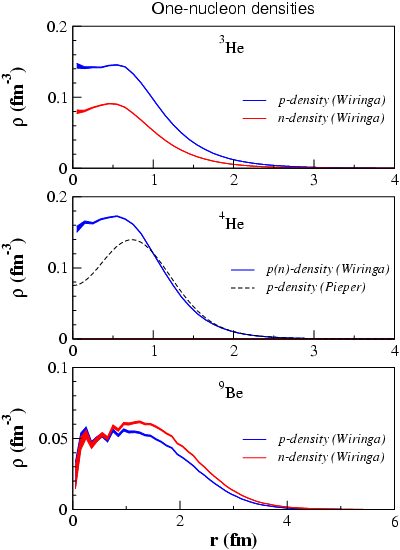
--> used the p-density distributions from Pieper for all other nuclei (average density= here). In fact I used the closest nuclei for the unlisted ones. Fig.2 shows the p-density distributions for a large number of nuclei:
Fig.2: Pieper's p-density distributions
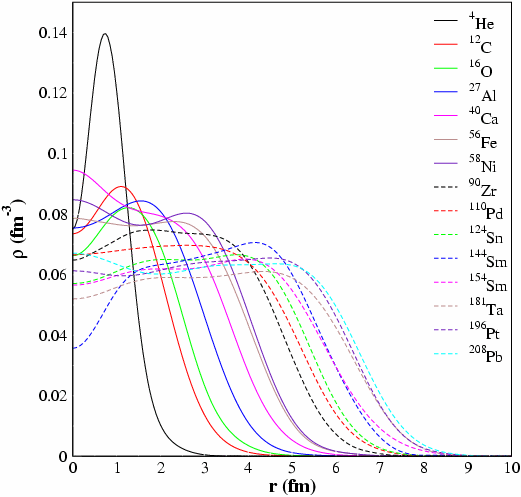
--> For reference, Fig.3 shows the average p-density versus A:
Fig.3: ρ versus A (left) and ρ*(A-1)/A versus A (right)
--> Finally, Fig.4 shows plots of the re-analyzed world data and the preliminary E03-103 data (from Sept. 2007) with coulomb corrections versus ρ and ρ*(A-1)/A at x=0.6.
Fig.4: ρ and ρ*(A-1)/A dependence of the EMC ratio at x=0.6. The fit includes all nuclei i.e. A>=3
OBSERVATION: Berylium is really off and pulls down the fit.
10/04/2007
- Donal sent me the data from the paper (PLB274) and the world data used
in the paper. Fig.1 shows a comparison between Donal's data (fig.2(b) on PLB274) and my extraction using the same world data
as inputs (file emc.dat_nmc). Some discrepencies can be seen: Does emc.dat_nmc contain more data than used in the paper ?
Fig.1: checking my code

Fig.2: Re-analysis using all world data and applying coulomb correction
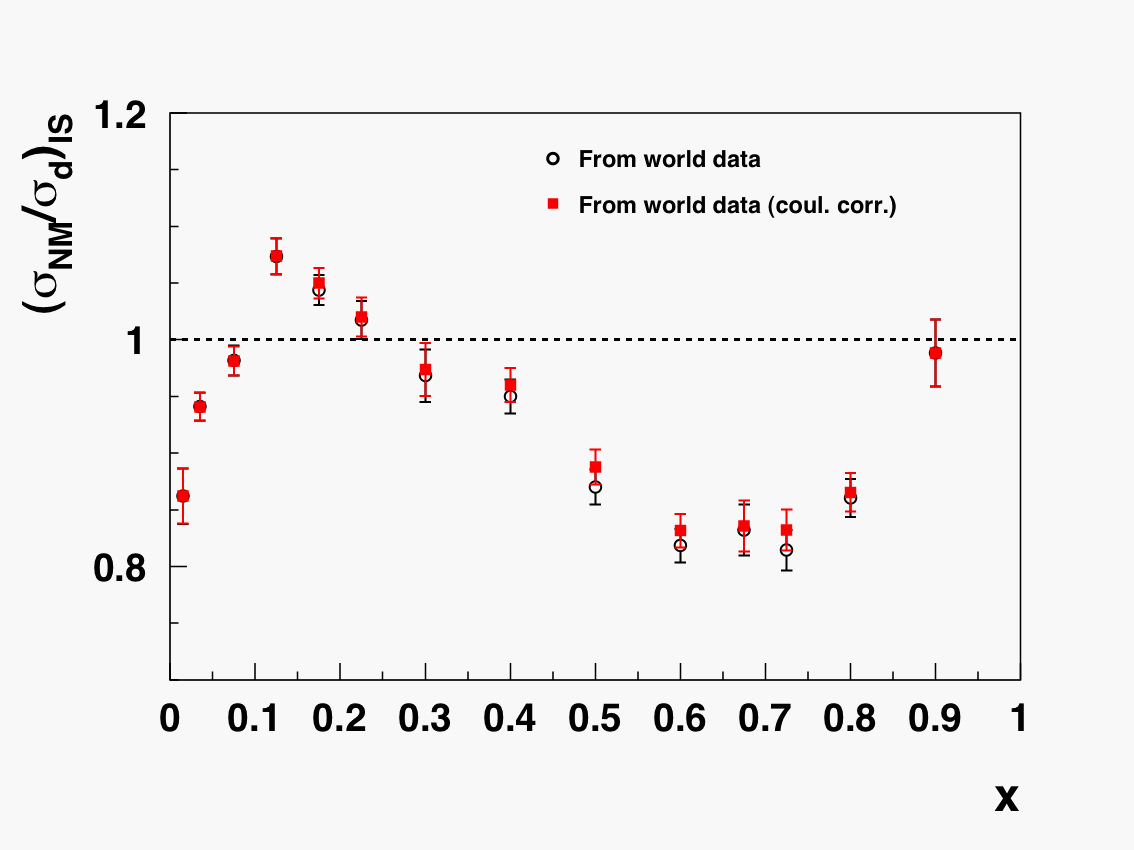
Fig.3(a): Nuclear matter from PLB274

Fig.3(b): Nuclear matter including all world data (after coulomb corrections)
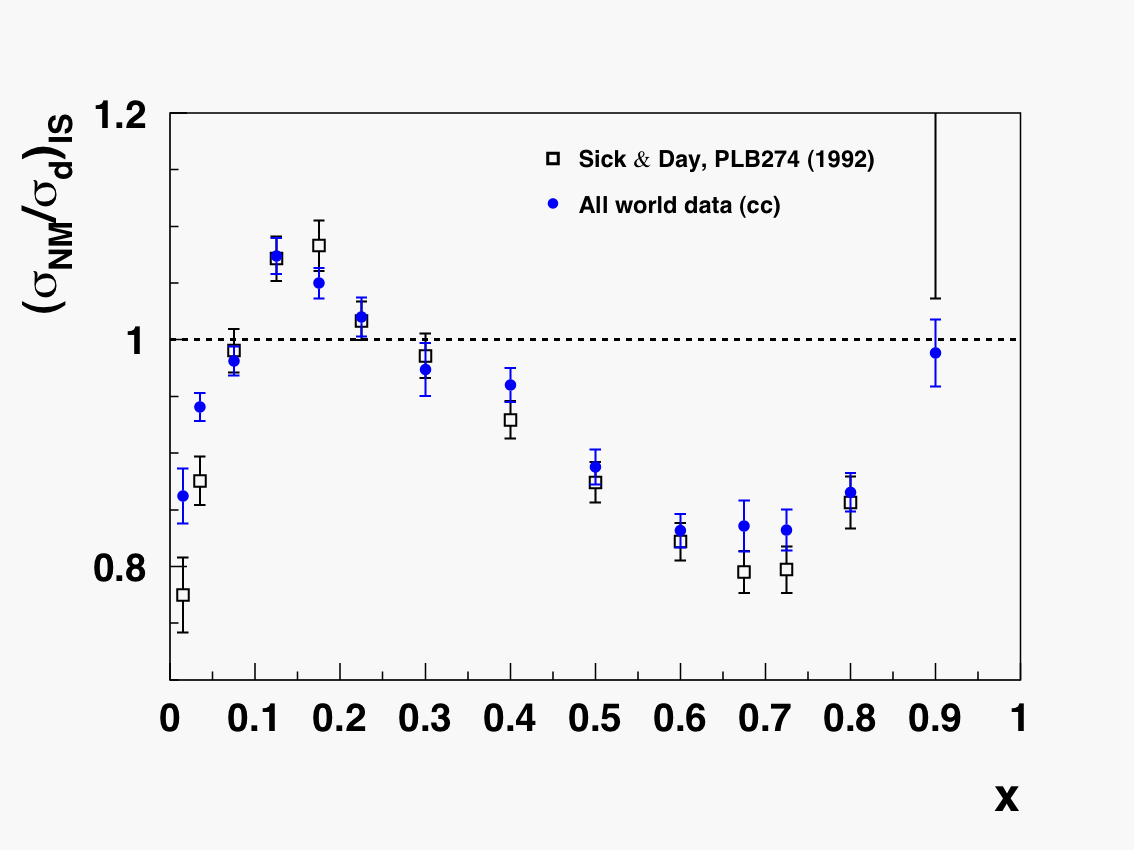
Fig.3(c): Nuclear matter with all world data and E03-103 preliminary data (after coulomb corrections)

- Now a look at the nuclear matter extrapolation fits. All the following plots displayed the data for A<12 but they were not used in the fit. You can notice that for some nuclei the error bars from Donal's data are smaller than the world data re-analysis. It can seem wierd since there are more data available now. In fact the re-analysis doesn't exactly use the same data. For exemple, and what I think is making the most part of the difference, is that in PLB274 the averaged Q2 fine binning in Table VIII of Gomez and al (PRD49 (1994), 4348) are used. For the re-analysis, since I wanted to apply the coulomb corrections, I had to use the data from Table VII (PRD49 (1994), 4348).
Fig.4: Using Donal's data at x=0.6

Fig.5: Re-analysis of world data at x=0.6 (no coulomb corrections)
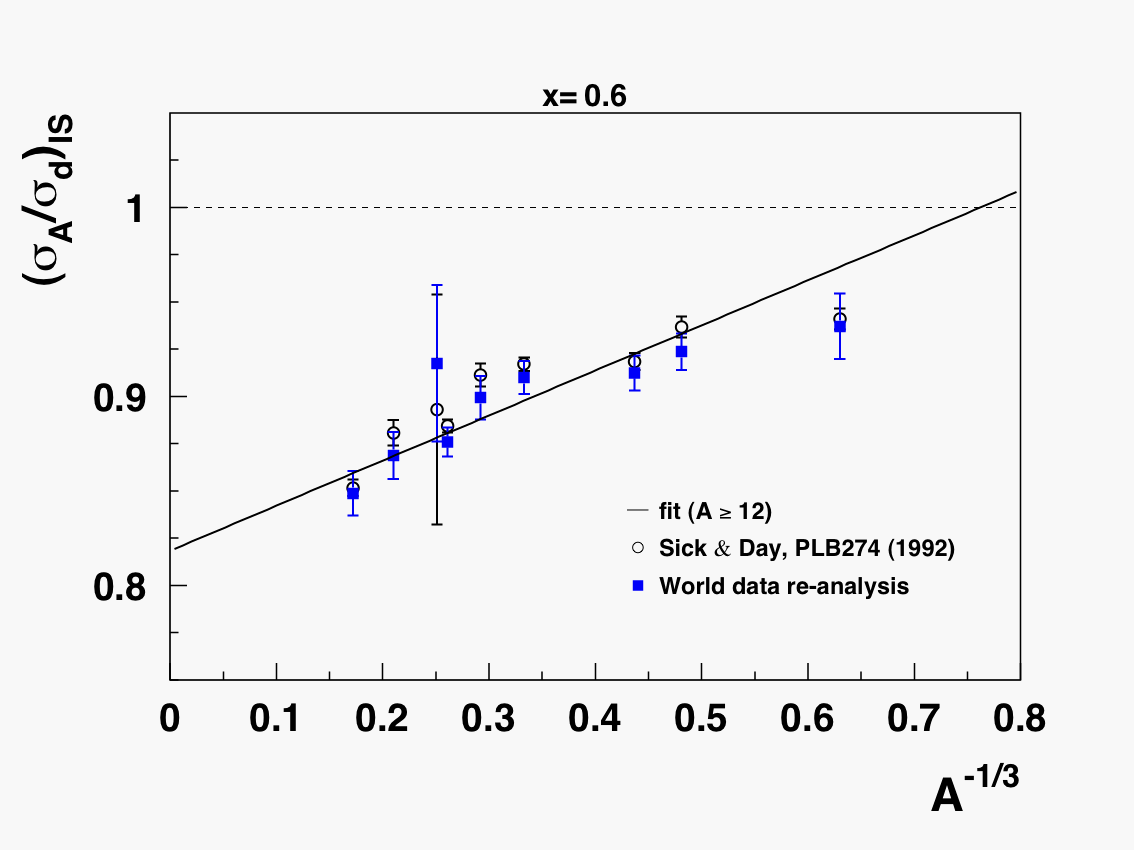
Fig.6: Re-analysis of world data at x=0.6 (with coulomb corrections)

Fig.7: Re-analysis of world data at x=0.6 and including E03-103 preliminary data (with coulomb corrections)

Fig.8: Same plot as Fig.7 but with E03-103 data separated from the world data (with coulomb corrections)

Fig.9: Using Donal's data at x=0.725

Fig.10: Re-analysis of world data at x=0.725 (no coulomb corrections)

Fig.11: Re-analysis of world data at x=0.725 (with coulomb corrections)

Fig.12: Re-analysis of world data at x=0.725 and including E03-103 preliminary data (with coulomb corrections)
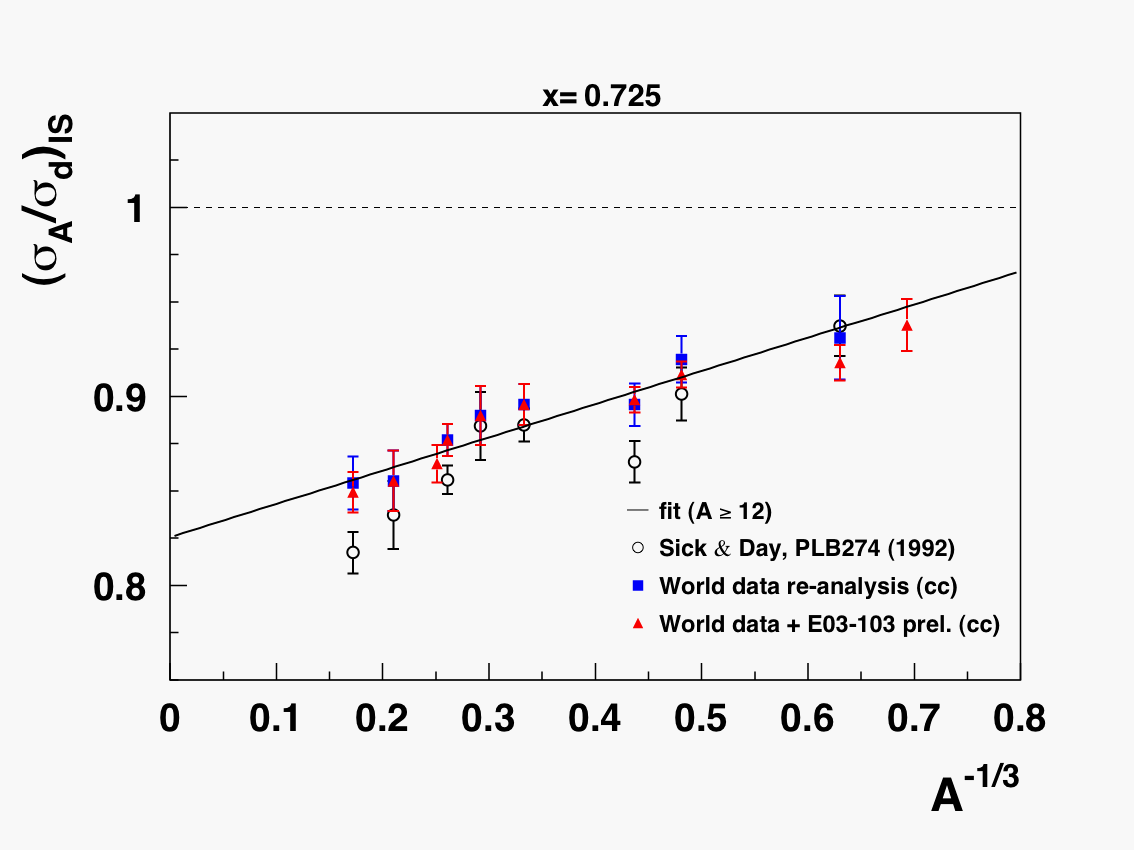
Fig.13: Same plot as Fig.12 but with E03-103 data separated from the world data (with coulomb corrections)
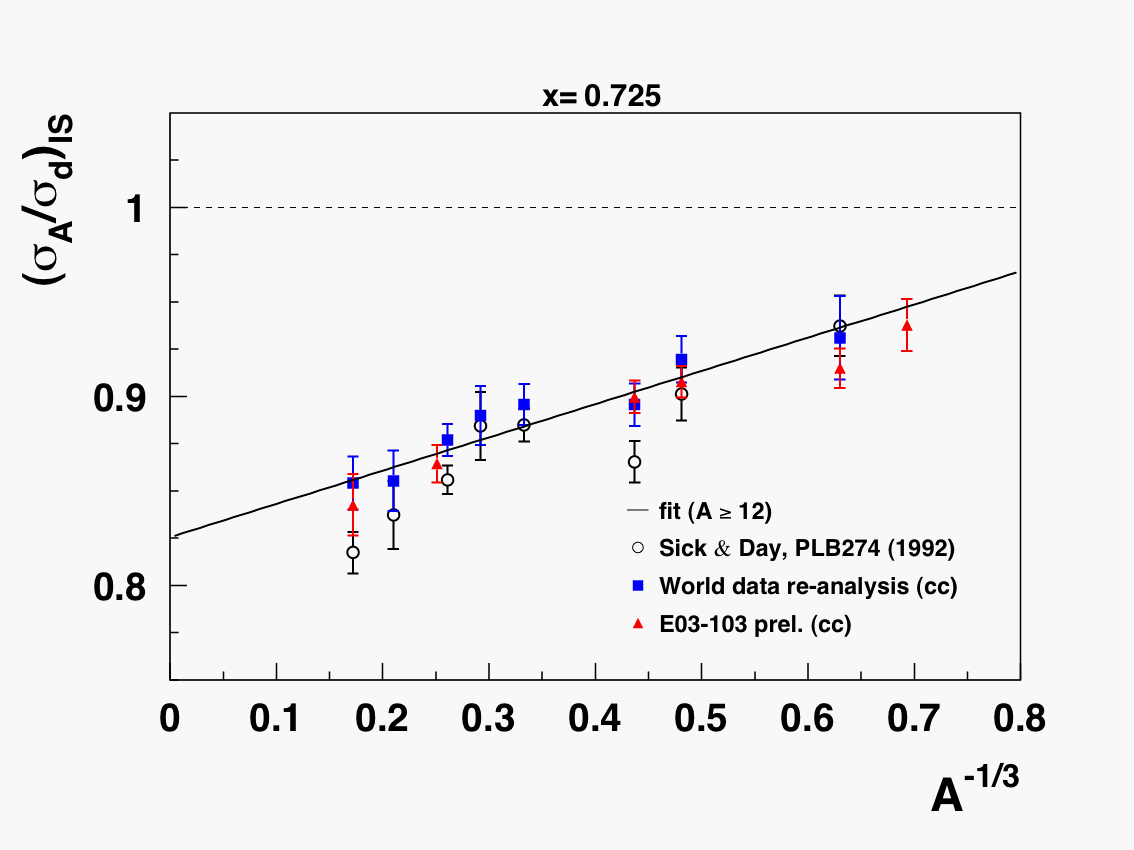
10/03/2007
- Extrapolation to nuclear matter using same data as in
Donal's paper (PLB274 (1992) 16), trying to bin the same way (in fact I will need the data from the paper) and
not applying the coulomb corrections. (see fig.1). I found some disagreement a low x (x<0.2: not exactly the same shape
but same magnitude) and at high x (x=0.8, the error bar is about 3 times larger). Otherwise pretty good agreement. So I
am checking the input data (might be some missing). In fig.4, the same data after coulomb corrections are shown in red.
Fig.1: Nuclear matter using same world data as in PLB274

Fig.2: Nuclear matter extrapolation at x=0.6

Fig.3: Nuclear matter extrapolation at x=0.7
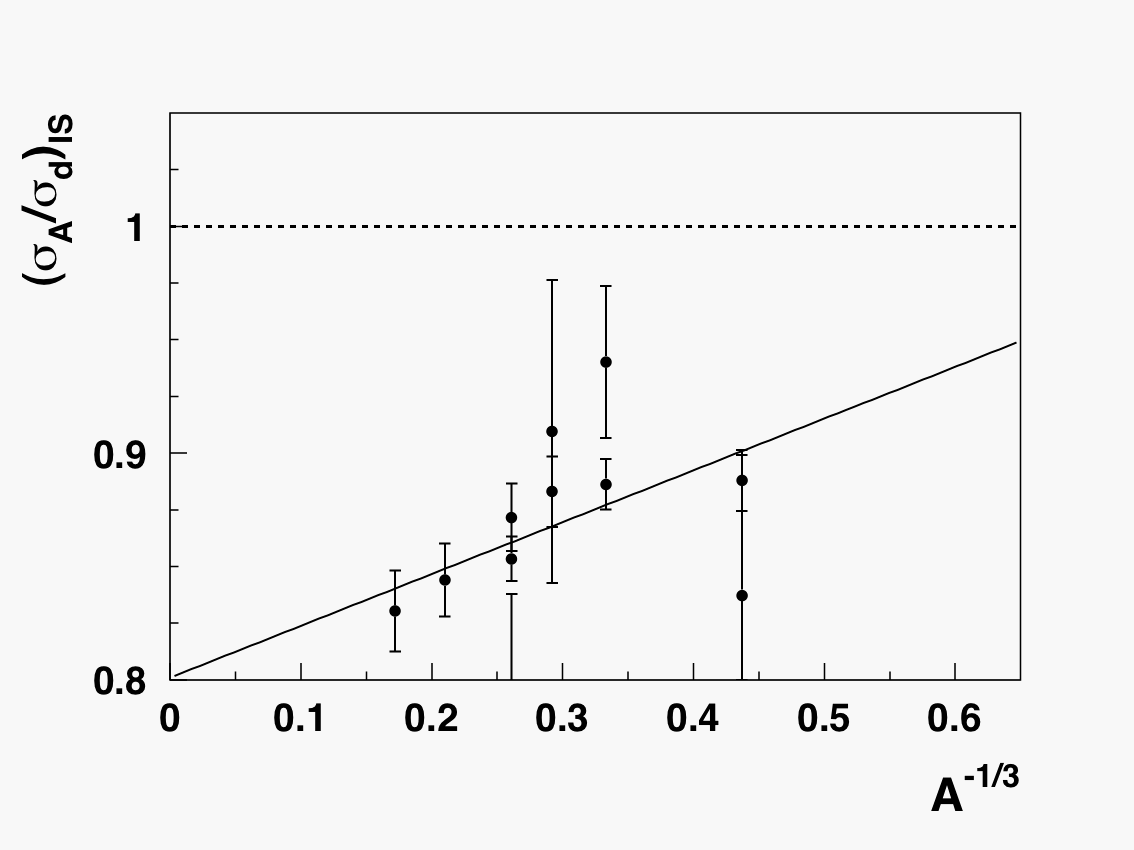
Fig.4: Nuclear matter using same world data as in PLB274 (black) and after applying coulomb correction (red)

- Extrapolation to nuclear matter using world data.
Fig.5: Nuclear matter world data
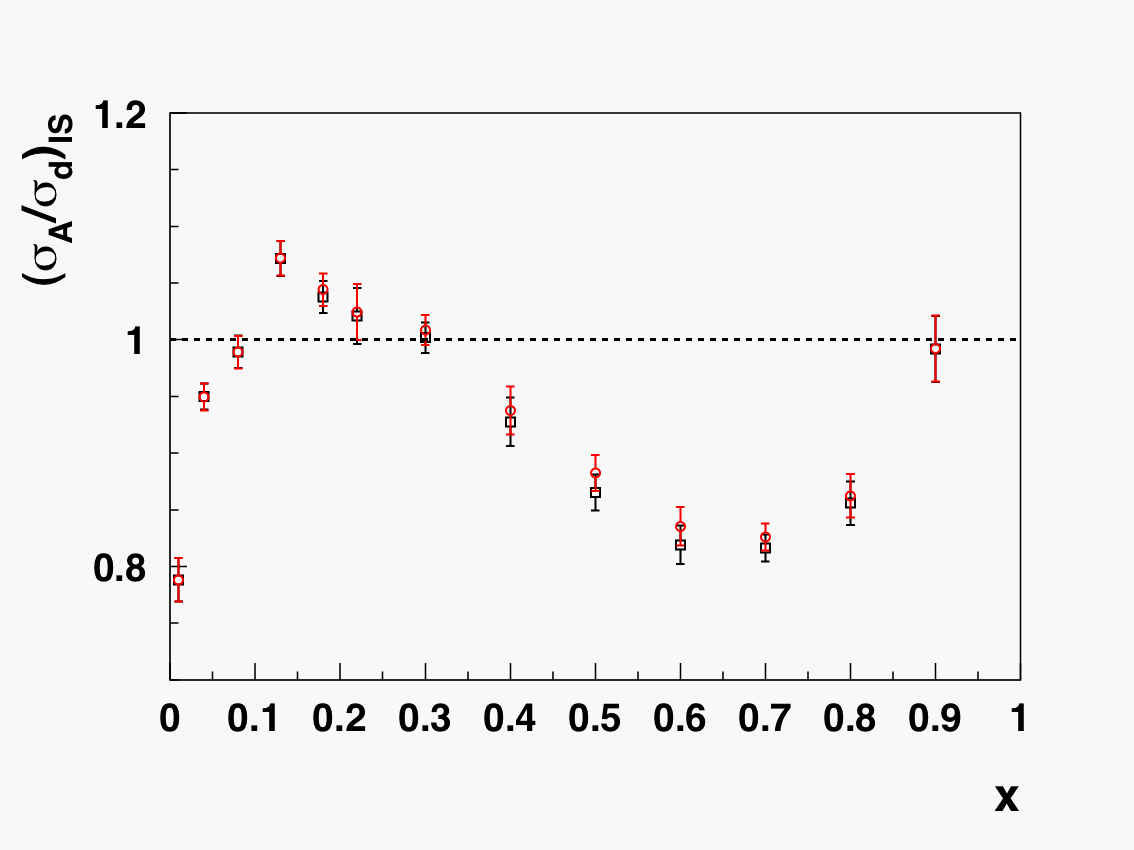
- Extrapolation to nuclear matter using world data + E03-103 prel. Statistical errors + an approximative systematic uncertainties were used in E03-103 data.
Fig.6: Nuclear matter world data + E03-103 prel.

- Nuclear matter improvement over the years (comparison before Coulomb corrections):
Fig.7: Nuclear matter before coulomb corrections: only PLB274 data (fig.1) in black, world data (fig.5) in red and world+E03-103 (fig.6) in green

- Nuclear matter improvement over the years (comparison after Coulomb corrections):
Fig.8: Nuclear matter after coulomb corrections: only PLB274 data (fig.2) in black, world data (fig.5) in red and world+E03-103 (fig.6) in green
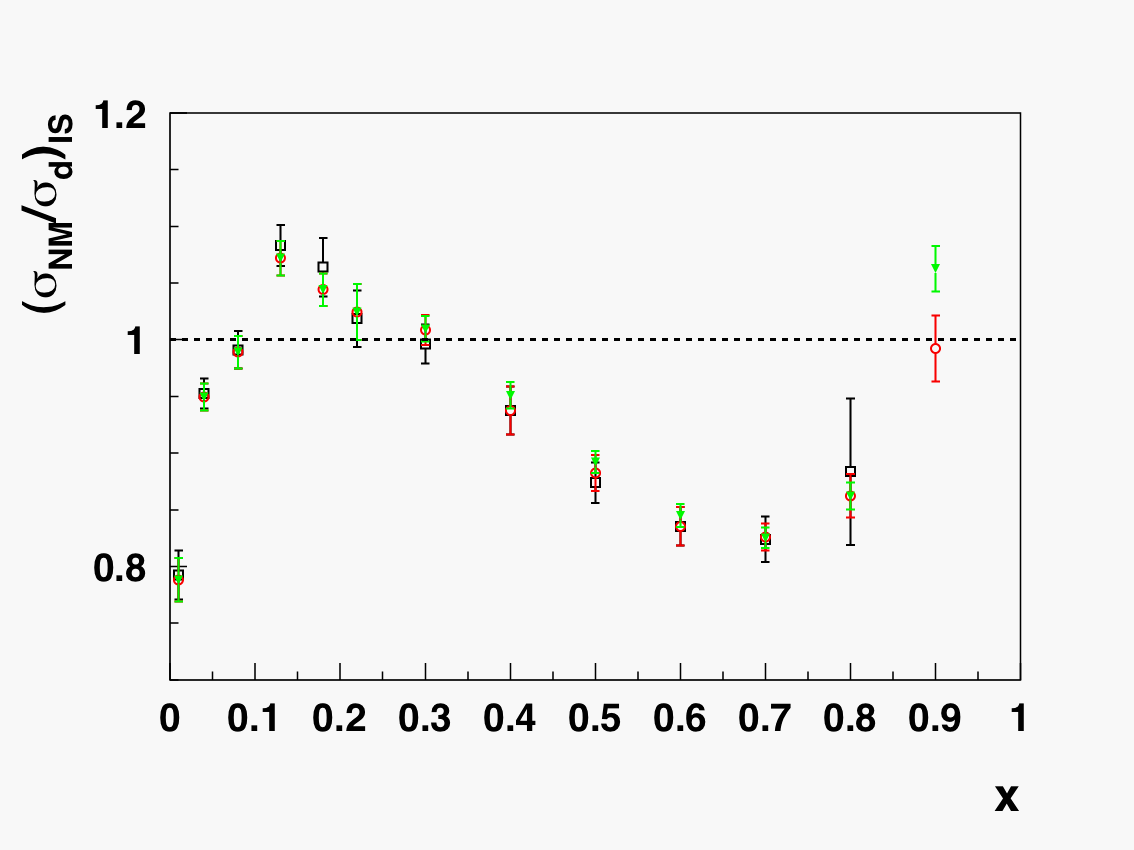
09/05/2007
- First look: click here
Patricia Solvignon
Last modified: Mon Jul 13 16:41:28 EDT 2009
























